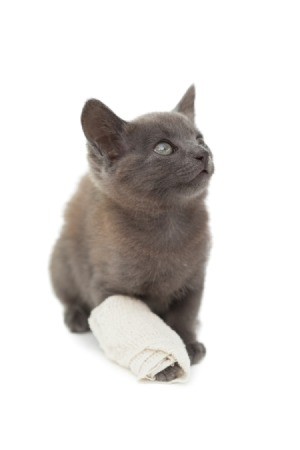 The following is an assignment I submitted on Feline First Aid. I thought it might be a nice addition to any feline first aid kit. Also I have provided lines at the bottom of the page to put the vet's phone number on.
The following is an assignment I submitted on Feline First Aid. I thought it might be a nice addition to any feline first aid kit. Also I have provided lines at the bottom of the page to put the vet's phone number on.
Cat or Kitten First Aid
- Perform CPR on your Cat:
A pet cat should be breathing and the cat's pulse should be 150 -200 beats per minute. If the cat is not breathing, CPR needs to be started as having been learned from a reputable source such as the Humane Society or the Red Cross. The pulse should be taken for fifteen seconds and then multiplied by four. The pulse cannot be obtained from the neck, but under the back thigh next to the abdomen or on the left side of the chest.
- Treat a Choking Cat:
If a person sees their pet cat pawing at it's throat, or acting frantic, is coughing or having difficulty breathing, then there is the possibility of a choking incident taking place. In the event of choking, remove the cat's collar, and look inside it's mouth and remove any obvious foreign objects. However, since a cat's anatomy includes small bones at the back of the throat that help support it's tongue, do not pull anything you feel out of the cat's back throat area without identifying what is is first. The Heimlich maneuver is very helpful, but must be done carefully, and from the teachings learned from a qualified source.
- Muzzling Your Cat:
Slip the muzzle over the cat's head from the back while someone else holds it by the scruff of the neck. Never muzzle a cat that has mouth injury, is unconscious, or has difficulty breathing.
- Treating Shock:
Most cats will be in shock after a serious or semi serious injury. The signs are weak pulse, shallow breathing, nervousness, and a dazed appearance. To treat shock, keep the cat restrained, quiet, and warm. If the cat has lost consciousness, keep it's head level with the rest of the body to prevent injury to the neck.
- Bleeding:
Treatment for bleeding includes putting pressure on the wound until the bleeding stops.
- Burns:
Treatment for burns is to put a cold compress on the burn.
- Broken Bones:
Bones need to be immobilized. If your pet cat has a fracture, lay the cat on a hard, padded surface and secure the animal to it. Wrap a broken limb with cotton padding and wrap with a magazine, rolled newspaper or towel, or two sticks to form a splint to keep it from dangling and falling from side to side. The splint should extend to one joint above the break to one joint below the break. Whatever materials you use to make the splint are then taped together. It must not constrict blood flow in any way.
If the cat's spine, ribs, hip, or other body part appears injured in a major way or broken, gently place it on a stretcher and immobilize the animal as best as you can. Seek veterinary attention immediately.
Important Phone Numbers:
______________________________________________
 The following is an assignment I submitted on Feline First Aid. I thought it might be a nice addition to any feline first aid kit. Also I have provided lines at the bottom of the page to put the vet's phone number on.
The following is an assignment I submitted on Feline First Aid. I thought it might be a nice addition to any feline first aid kit. Also I have provided lines at the bottom of the page to put the vet's phone number on.